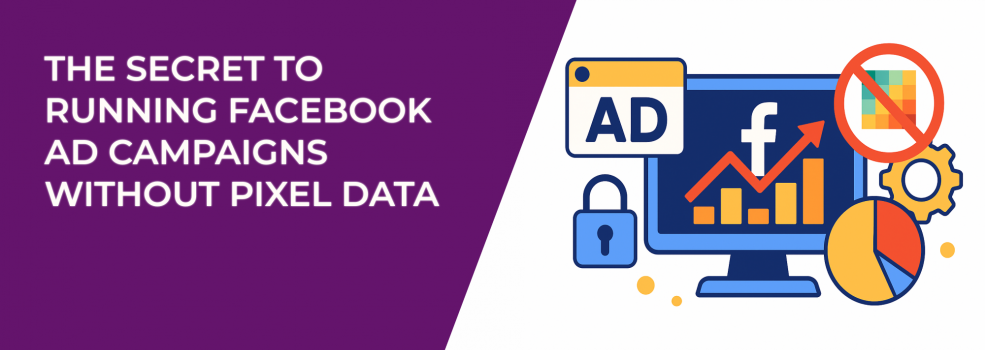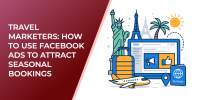Most marketers treat the Facebook Pixel like oxygen. Without it, they assume their ads will suffocate. But what if you could run effective campaigns without pixel data at all? You can — and in many cases, you should.
Pixel tracking is powerful, but it’s fragile. Cookies expire. Privacy rules evolve. Users block scripts. New brands and regulated industries often start with no tracking in place. That doesn’t stop great advertising. It just changes how you approach targeting, optimization, and measurement.
Curious how to do it with confidence? Let’s break it down.
Audience Research That Actually Replaces Pixel Signals
When you don’t have on-site data, your research is your data. Treat this step like laying foundations — everything else rests on it.
Three reliable research streams worth your energy:
-
Meta’s built-in data. Interests, behaviors, demographics, and placements still go far if you use them deliberately. Start broad, then refine using combinations. Explore techniques like interest stacking to build themed clusters that reflect buyer intent.
-
Your lists and conversations. CRM exports, newsletter subscribers, and even sales notes reveal patterns (titles, industries, locations, problems). Pull those threads and you’ll see distinct personas emerging.
-
Competitor and category analysis. Scan messaging angles, offers, and creative styles in Meta’s Ad Library. If you see repeated themes, there’s likely demand under the surface. For a step-by-step framework, see How to Conduct Facebook Market Research to Fine-Tune Your Ads.
Pro tip: Turn research into a short persona card (pain points, desired outcomes, social proof needed, objections). Use that card to sanity-check every ad decision you make.
Lookalike-Free Targeting: Design for Intent, Not Imitation
No pixel? No problem. You can still approximate high-intent reach.
A simple, durable setup:
-
Upload customer lists (email or CRM). Use them for inclusion, suppression, or to validate interest clusters.
-
Build themed interest stacks around problems and use cases (not just brands or job titles). Start with 3–5 interests per stack.
-
Add exclusions to keep quality high — for example, exclude “job seekers” if you want buyers. This matters more when you can’t rely on conversion signals. Learn when exclusions help in When to Use Exclude Targeting on Facebook and Why It Matters.
When you focus on intent-based design instead of imitation through lookalikes, your campaigns stay sharper and less dependent on fragile tracking systems. It also pushes you to understand your audience on a deeper level — which is a competitive edge most advertisers skip.
Creative That Pulls Its Own Weight (Because It Has To)
When conversion feedback is thin, your creative doubles as targeting. Strong ads attract the right people and quietly repel the wrong ones.
Ask these quick questions before you launch:
-
Hook: Does your first line stop thumbs in two seconds, or does it need context?
-
Clarity: Could a distracted scroller understand the offer at a glance?
-
Credibility: Do you show proof (mini case point, rating, testimonial) close to the CTA?
-
Specificity: Are you promising specific outcomes or speaking in generalities?
For format ideas and guardrails, skim The Ultimate Guide to Facebook Ad Formats and Crafting Compelling Facebook Ads Copy That Converts.
Tip for lean teams: Create a “creative bank” of hooks, angles, and visuals organized by funnel stage so you can test quickly.
Cookieless Measurement: Stack Signals, Don’t Chase Perfection
You won’t get a single source of truth. You don’t need one. Instead, layer signals to create a trustworthy picture.
Before the list below, set a baseline: define one primary goal metric (e.g., cost per qualified lead) and two directional metrics (e.g., CTR and landing page conversion rate). This prevents dashboard overload.
The measurement stack that works without a pixel:
-
UTM discipline. Tag every ad with campaign, ad set, ad, and content fields. This makes Google Analytics reporting useful again.
-
On-platform leading indicators. CTR, hold-out tests, scroll depth on Instant Experience, and video completion rates reveal early quality. Learn what to weigh in How to Analyze Facebook Ad Performance Beyond CTR and CPC.
-
Manual attribution touchpoints. Add “How did you hear about us?” to your forms. Track first-touch vs last-touch in your CRM fields.
-
Blended view. Tie spend to pipeline metrics (SQLs, revenue) weekly, not daily, to avoid knee-jerk changes.
Wrap up each week with a simple narrative: “What moved? Why? What do we test next?” Your team will make sharper decisions with less data drama.
The No-Pixel Power Move: Facebook Lead Ads
Lead Ads shine when you need first-party data without sending users off platform. They’re fast, mobile-friendly, and easy to test.
How to keep Lead Ads high-quality:
-
Short forms win the click; smart follow-ups win the deal. Ask for name + email + one qualifier (role, timeframe, or budget). Then segment with your welcome email sequence.
-
Use custom questions sparingly. One multiple-choice question beats three open-ended fields for completion rates.
-
Sync instantly to your CRM or ESP. Respond within five minutes — speed matters.
Want to go deeper? Compare approaches in Lead Generation Ads vs Conversion Campaigns and optimize forms with What Makes a Facebook Lead Form Convert? and How to Optimize Facebook Lead Ads for Higher Conversion Rates.
Build a Funnel Without Retargeting
You can create momentum even without website retargeting pools by leaning into engagement-based audiences.
A lightweight, three-stage funnel:
-
Awareness: Educational video or carousel that addresses a pain point. Optimize for ThruPlay or engagement to seed audiences.
-
Consideration: Lead Ad with a simple value exchange (checklist, calculator, consultation). Qualify lightly.
-
Close: Email nurtures with proof, FAQs, and a clear “book now” or “get pricing” CTA.
This type of funnel proves that you don’t need a pixel to guide users through the buyer’s journey. By focusing on engagement and first-party data capture, you’re building audiences that grow stronger over time. It may feel slower at first, but it creates a sustainable system that compounds results without relying on fragile retargeting pools.
Campaign Blueprint: A No-Pixel Launch You Can Copy
Here’s a clean, reusable structure you can stand up in a day.
Campaign 1 — Awareness (Engagement/Video Views)
-
2–3 ad sets, each a themed interest stack.
-
2–3 creatives per ad set: one short video, one carousel, one static.
-
KPIs: 3-second views, cost per engaged user, CTR link.
Campaign 2 — Leads (Lead Generation)
-
2 ad sets: highest-quality interest stack vs broader “adjacent interest” stack.
-
Lead form with 3 fields total; one qualifying multiple-choice.
-
KPIs: CPL, lead acceptance rate, time-to-first-reply.
Campaign 3 — Validation (Traffic or Engagement)
-
Run 1–2 “why us” creatives to your most engaged audience (video viewers 50%+, page engagers).
-
KPI: session quality (time on page), reply rate on email follow-up, discovery call bookings.
Once this is live, use the next section’s tests to refine.
What to Test First (When Budget Is Tight)
You can’t test everything. Prioritize changes that shift outcomes the most.
High-leverage test order:
-
Offer → lead magnet vs consultation vs pricing guide (biggest impact on CPL and quality).
-
Hook → first 2 seconds of video / first line of copy (impact on thumb-stop and CTR).
-
Audience theme → problem-based vs persona-based stacks (impacts quality and CPM).
-
Format → short video vs carousel vs static (affects delivery and comprehension).
Need a deeper framework? Try Key Strategies for Facebook Ad Testing.
Troubleshooting Without Pixel Data
Performance wobbling? Work through this sequence before you rebuild everything.
A practical checklist:
-
High CTR, low lead quality: Tighten the qualifier question; clarify the offer; exclude mismatched interests.
-
Low CTR, decent CPM: Rewrite the hook; try a punchier visual; reduce jargon; test a carousel explainer.
-
Good engagement, expensive leads: Test a simpler offer; shorten the form; adjust placements after reviewing delivery in Ads Manager.
-
Stable CPL, revenue lagging: Improve handoff speed; personalize the first email; add a trust-building touchpoint (quick case snippet or testimonial).
Following this order keeps you from overreacting and burning valuable data. Each adjustment addresses the specific weak point instead of scrapping the whole campaign. Think of it as tuning a machine — small, precise tweaks often get you back on track faster than rebuilding from scratch.
Budgeting and Scaling When You Can’t Trust Conversion Data
Scale with caution. Without rock-solid attribution, you’ll need guardrails.
Simple guardrails that work:
-
Raise spend in small steps — 10-15% increments every 48-72 hours while monitoring leading indicators.
-
Protect winners by duplicating the ad set before edits.
-
Shift spend toward audiences with stronger downstream email metrics (opens, replies, bookings), not just low CPL.
Learn more in The Science of Scaling Facebook Ads Without Killing Performance and When to Scale, Pause, or Stop Your Facebook Ads.
Final Thoughts
Running Facebook campaigns without pixel data isn’t a handicap. It’s a test of strategy and discipline. When you do your homework, design for intent, and let your creative carry more weight, you’ll build a system that’s resilient — and ready for a cookieless future.

